Editor’s Staff
Lost Occupations
Some very old and often inane expressions that concern an individual’s state of mind, soul, and body would be funny if the situations they explained weren’t so true. “You are what you eat” and “What you do make you you,” are two of them. And then there are the advice adages like the one below, telling you to “Cheer Up.”
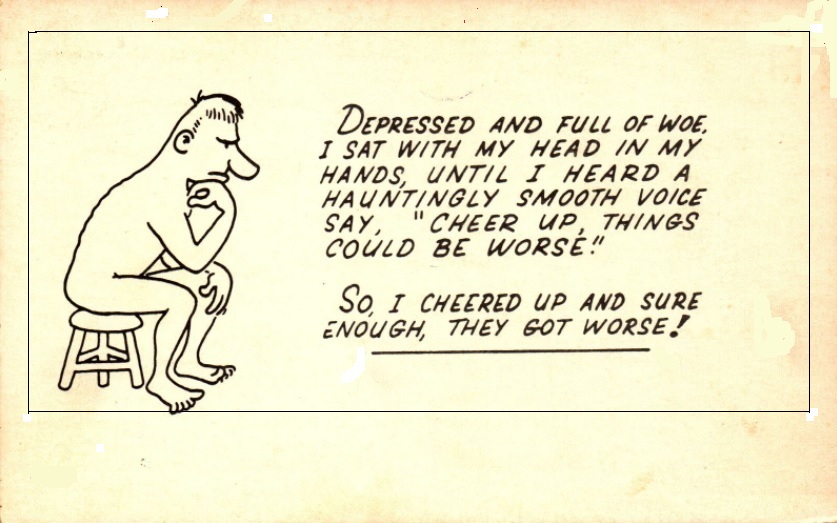
Today, after the last twenty-plus months of the pandemic are at least in part behind us, many workers around the world are looking for a fresh start. Tens-of-millions are making plans to return to their downtown offices instead of working at their dining-room tables. But for many, there is the unanswered question: what kind of a job do I want?
Since Postcard History looks back at most everything, we will offer no advice on looking forward, so from a collection of well over a thousand postcards of people “at work” your editor has chosen five that illustrate jobs that may seem rewarding, but you may find better employment elsewhere.
The following employment opportunities may be dubbed “lost occupations,” but certainly there are a couple people in the world still doing these jobs. Which is to say, the world only needs a couple people doing them. The few who are left are in a constant conflict with technology and mechanization.
The nations where the jobs were being done when these postcards were made include China, France, Scotland, England, and the U.S.A.
Umbrella Makers
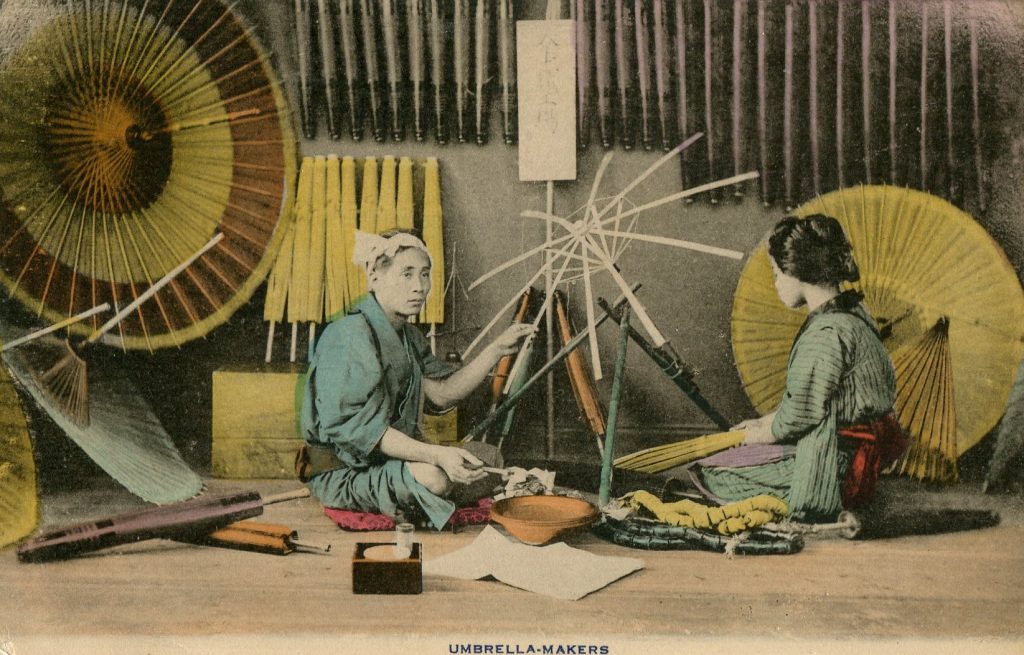
The umbrella is one of the most cherished inventions in history. It is a personal choice to use an umbrella and to use one is an intuitive experience that is now nearly four thousand years old. The remnants of ancient umbrellas have been found in the historic regions of Mesopotamia. Since that area has a near desert climate historians are unsure if the umbrella was invented as protection against the sun or against rain.
The theory has been advanced that the first umbrellas had canopies of palm leaves, papyrus, and bird feathers. Some folded; some did not. When the umbrella found its way to Egypt it was considered a fashion accessory for the upper classes. The parasol and umbrella for certain experienced what anthropologists call “simultaneous creation.” Parasols of nearly the same age have been found in China made from bamboo sticks and leaves as well as bone and woven seaweed.
Have you ever been to an umbrella factory? If you want to work in one there are factories in Rhode Island, New York, Maine, Pennsylvania, and Maryland.
Walking Librarian
If being a walking librarian is a job you would like there may be a position open in London, England.
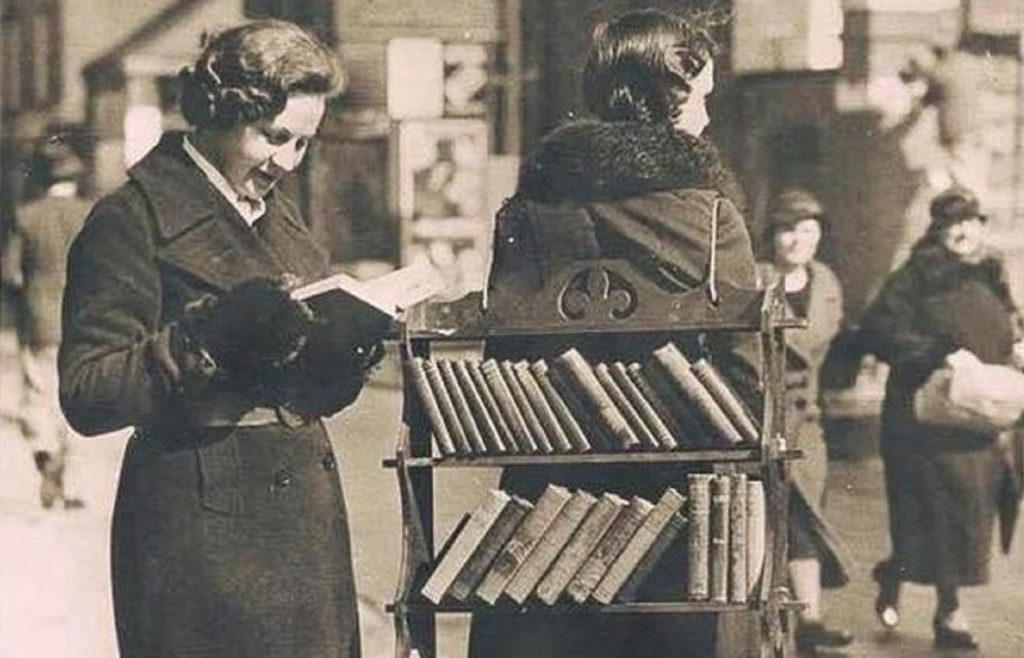
This postcard comes from the 1930s. Apparently it was first used in a human-interest story in a London newspaper. It has appeared in at least three accounts on the internet detailing stories of women at work during the Great Depression.
Being a walking librarian was a simple undertaking. First you had to establish a route and walk the same path at the same time on the same day each week. You had to force your clientele to develop the habit of meeting you regularly. Then you set out each day and asked everyone you met if they would like to “let-a-book.” The walking librarian would often affiliate themselves with a local organization that rented or loaned books. Private libraries, with higher quality books often employed walking librarians as ambassadors who handed out applications and who eagerly sold membership subscriptions. The street fee was structured and very economical – in the 1930s it cost tuppence a week and another farthing if you returned the book past its due-date. (Today that would be right around nine cents.)
As you can see from the card, the walking librarian didn’t need much equipment. Take your teacup rack from your dining room, fashion it with ropes or straps that would enable you to carry the books with a minimum of effort and a penny-pocket to hold the money your customers would give you.
Today Mini Libraries are found in many parts of the world. Some are the size of mailboxes while others are fitted to the passenger seats on motorbikes or scooters. Good reads make good friends.
Knocker-Uppers
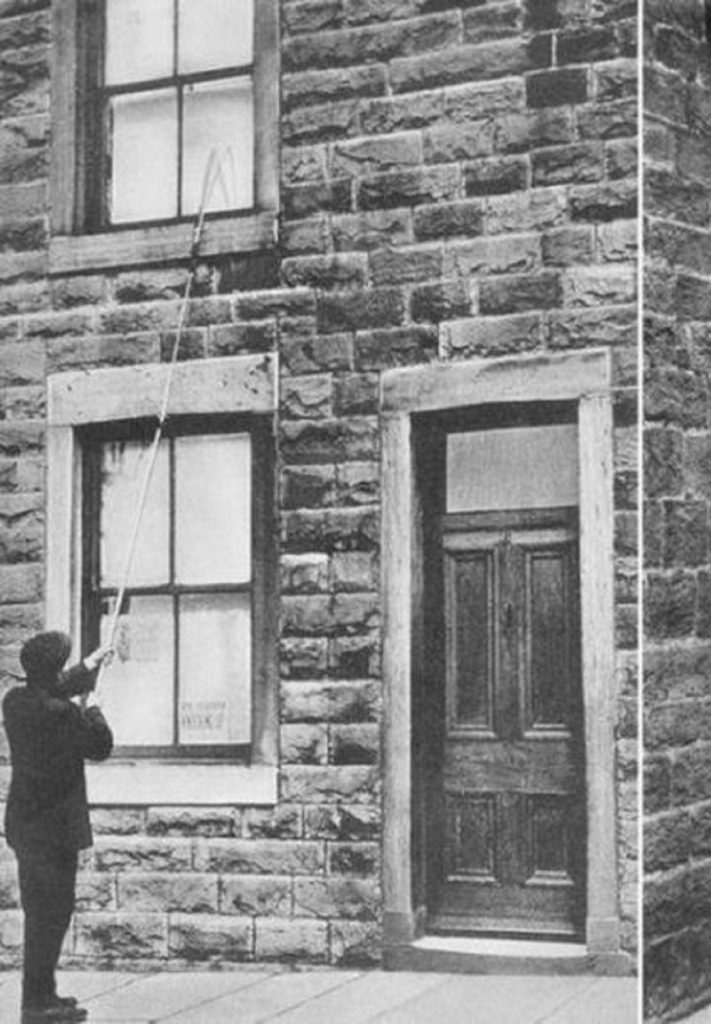
The first alarm clock came to America in 1787. Levi Hutchins invented it to wake him for work at 4 AM – it had no other setting.
Sixty years later in France a clockmaker named Antoine Redier made a mechanical alarm that was adjustable.
The Greenwich Museum in England has a collection of time pieces that cannot be rivaled – it is well-worth a visit, but the concept those alarms represent – that of being awakened at a certain time each day – is lost in time.
Anyone interested in doing a time-honored job needs to become a “Knocker-Upper.” If you lived in Scotland prior to the age in which biotechnology took hold of the reins of history, you could make a healthy living waking people from their sleep. The amount you earned depended on many factors: the number of clients you had, the means by which you woke your clients, and the time at which they required your service.
The average salary would be a shilling per week per person. Earlier hours – like 4- or 5 am warranted higher fees. If you knocked on a door it was more expensive than scratching on a windowpane or shooting peas (with a blowpipe) at a window. Some knocker-uppers serviced as many as a hundred clients each morning and most charged extra if they were expected to wait for a signal that their client was awake and out of bed.
The knocker-upper was a respected profession well into the 1950s; even into the 1970s in some parts of the United Kingdom. As you may expect, there is little need for Knocker-Uppers today. The job is now entrusted to the cellphone.
Floor Planers
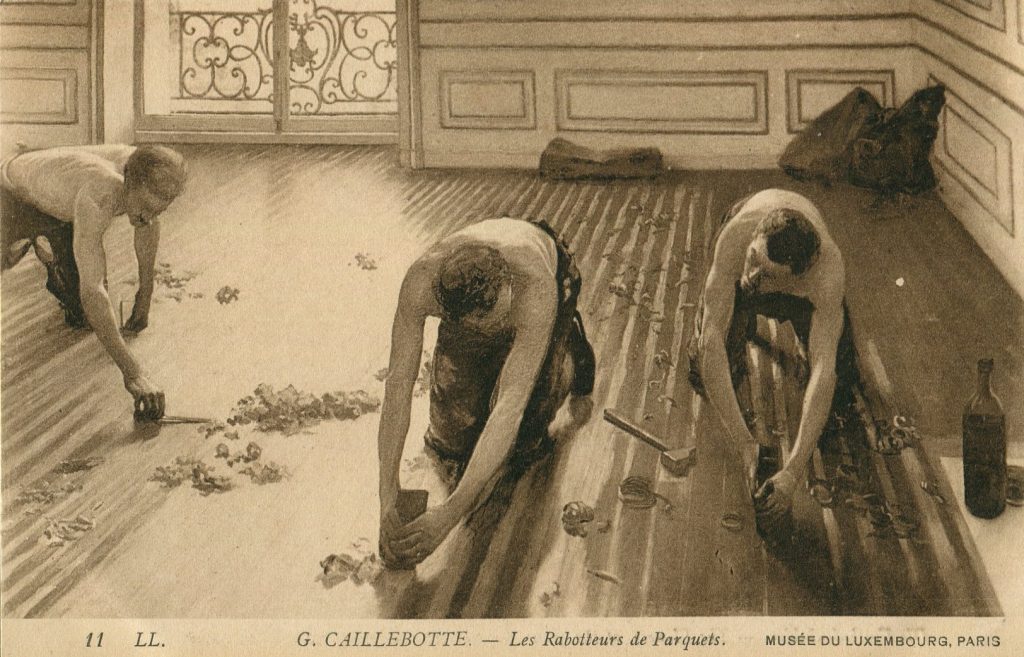
Many millions were forever grateful when electric motors were added to machines that alleviated the labor of those who worked on their knees.
The postcard above entitled Les raboteurs de parquet is an oil painting by French Impressionist Gustave Caillebotte. It fully expresses the backbreaking experience of leveling a wooden floor. Today electric sanders will accomplish a job like the one in the painting in hours instead of days.
There are very few written accounts that detail the benefits of being a professional flooring installer or maintenance man, and not surprisingly even fewer accounts of the hazards. Nevertheless the mostly male flooring installers, including carpet layers, can find work in a surprising number of industries. Especially where wooden floors are most popular.
When you travel across America and in European cities to visit historic homes and castles nearly everyone develops a greater appreciation of the skills needed to lay parquet floors. Precision being one.
Telling Time
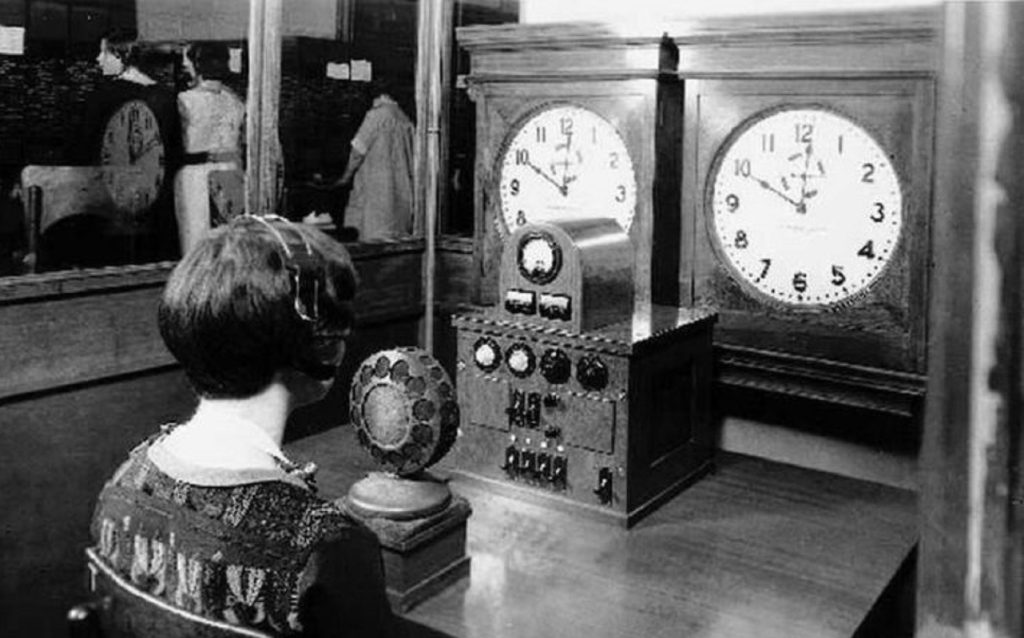
Ernestine, the telephone operator portrayed by Lily Tomlin in a 1969 episode of the TV show “Laugh-in” never worked at the time-desk. The time-desk was a service provided by the phone companies of the era. The men and women who worked there were very serious-minded individuals whose duty it was to keep America moving and on time! On Time was an expression first developed by the railroads. It was an important concept. With that in mind, let’s remember . . .
What was the first telephone number we taught our children? Assuming that most of us are in our retirement years, the answer is “9-1-1,” right? But that always came with a caveat. Don’t call 911 unless it’s an emergency. Let’s face it, the vast majority of kids don’t experience emergency situations. So, kids are curious and they call 911 just to see what happens. That usually results in a conversation with mom or dad that includes a warning – Don’t do it again, except in an emergency. Case closed!
Then one day our children learn another telephone number they can call without getting in trouble. The “Time-Desk.” You could call any time of day, any day of the week, or any week of the month. Someone always answered in a very pleasant tone.
It went something like this. Beep, beep, beep, beep, beep. (There were usually five beeps, to set the system in motion.) Then the voice would say, “At the tone, the time will be exactly 3 hours, 22 minutes and 45 seconds.” And from that you knew darn-well the exact time of day. Later we learned that the exact time could have been as much as 1/1100th of a second plus or minus. Oh, well nothing’s perfect.
The telephone time-desk remained in operation until 2007.
Except, did you know that a similar service is still provided by the U.S. Naval Observatory?
The observatory’s time-by-phone line receives more than three million calls a year for the exact time of day. You can call as often as you like. You can listen for as long as you like to the 24-hour system announcements. If you’re of a certain age, you are transported back to a time when just about everyone was familiar with the phrase “At the tone the time will be…”.
If you don’t believe me, try this: dial 202-762-1401.
If you called, just because you’re curious, confess in the comments below and tell us what time you called. If you didn’t call, did you cheer-up? And, did things get worse? We hope, not!
Eastern time: 11 hours, 47 minutes and 15 seconds.
Delightfuland informative.
In Cleveland, the number for the time was GReenwich1-1212 (471-1212). It got a lot of use after power failures and on the days people had to “spring forward” or “fall back”.
Metro Detroit it was & still is GReenleaf2-1212. Exact reasons!
I saw the rack on the librarian’s back, but until I read the article I didn’t really give much thought. Both my mother & my neighbor had tea cup racks similar to that. Both used them for knick knacks. I’m going to call, but here in Metro Detroit you can still call (313) 472-1212 for time & temperature. 👍
Another lovely article. In Baltimore the # was TI-4-1212, It automatically hung up after one minute. As a child of maybe 10 I was awake one year when my parents where having a New Year’s Eve party in the cellar. Upstairs, I wanted to hear the exact moment of the New Year on the phone. At 5 minutes until midnight I started dialing and it was busy. No redial back then, rotary phone. I kept dialing figuring if I got through and tied the line up I would be able dial back quickly. It was readily apparent to me others… Read more »
Bringing Up Baby had a funny scene where Katherine Hepburn tried to gum everything up by pretending to be the time lady.
Tried the phone number at 5pm on 5/8 …. no answer – just ringing.
May 8th at8:31 rang 11 times no answer oh well!
Lovely I know the time! Locally we had TI 4-1414 I wouldn’t have thought to call, and why? (phones and computers) I called 202-762-1401 and it worked. I know this is going a little off but the US Observatory WWV I think Fort Collins Colorado unless that changed, 5 MHz, 10 MHz, and 15 MHz; and 2500 W on 2.5 MHz and 20 MHz much the same as the time I heard on the phone call.
Thanks that was fun!